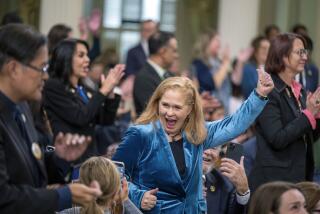A News Idea for California
The almost total absence of serious broadcast news coverage of the California Legislature is shameful. Since late last year, no major television station outside of Sacramento has maintained its own state capital bureau. Television coverage occurs primarily when there are major scheduled events forthcoming, such as the governor’s State of the State address, or when there is some scandal or silliness to shock or titillate listeners and viewers.
The economics of the broadcasting industry is not likely to bring about any sudden change, but there is something of a solution available: Gavel-to-gavel transmission of Senate and Assembly sessions, committee hearings and other legislative events through a proposed California Channel similar to C-SPAN, which covers sessions of Congress and national political events in Washington.
The outline of the plan was released Monday by California Channel, a nonprofit corporation that unveiled a 350-page study of broadcast news coverage of official Sacramento and the feasibility of a California equivalent of C-SPAN. The study by USC communications professor Tracy Westen found that of all the 50 states, only Wyoming and Montana provide less broadcast coverage of legislative affairs. During a study period, California radio and television stations devoted less than 2% of their news coverage to state government. A majority of California citizens surveyed said they were dissatisfied with the amount of news they receive from Sacramento.
The report proposed installation of cameras in the two legislative chambers, the major committee rooms and in the Capitol’s press conference room. Coverage would be transmitted via satellite to cable television companies throughout the state, which would be asked to broadcast the events on available vacant channels. Transmissions also would be available to radio and television stations, print media news bureaus, lobbying associations and others. Television stations could snip portions of the meetings for use in their regular news programs.
The proposed start-up costs are $1.1 million to $2.1 million from the Legislature for camera installation and other technical facilities and up to $2.8 million for California Channel, which would direct the operation, conduct interviews and develop other state government programming.
The plan deserves serious consideration and possible further study as to whether cable television is the best or only outlet available for Sacramento transmissions. The operation could succeed only if the Legislature had no editorial control over what is broadcast. And there needs to be a careful assessment of the cost to make certain that California Channel had enough financial support to maintain a first-class operation.
The success of C-SPAN in Washington should relieve Sacramento of any fears of the cameras focusing in on legislators addressing an empty chamber, reading newspapers during a serious debate or falling asleep at their desks. In fact, more thorough coverage of Sacramento would help educate Californians to the fact that there are many serious lawmakers who devote long hours on mundane but important state issues. It would not hurt for Californians to know more about some of the good work their legislators do rather than just the scandalous and silly stuff.
More to Read
Get the L.A. Times Politics newsletter
Deeply reported insights into legislation, politics and policy from Sacramento, Washington and beyond. In your inbox three times per week.
You may occasionally receive promotional content from the Los Angeles Times.










